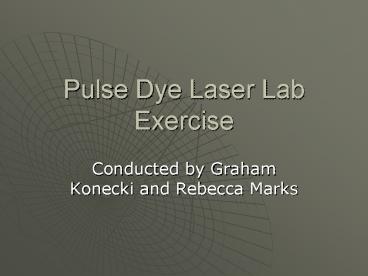Pulse Dye Laser Lab Exercise PowerPoint PPT Presentation
1 / 12
Title: Pulse Dye Laser Lab Exercise
1
Pulse Dye Laser Lab Exercise
- Conducted by Graham Konecki and Rebecca Marks
2
Background Information
- Dye lasers were discovered in 1966 at an IBM
research center. - Popular because of low cost and adjustability
- Works by stimulating the electrons in the dye
with either pulses or continuous wave light - Rhodamine 6G is a popular dye because its
nontoxic, cheap, and versatile
3
Goals
- To attempt to use a N2 laser to stimulate a vial
of Rhodamine 6G to lase. - To attempt to diffract the secondary beam to
observe its wavelength components
4
Procedure
- Clean everything with lens paper and lens cleaner
solution - Once Nitrogen laser is pulsing and dye is
scintillating, adjust the vial position relative
to the Nitrogen laser until the pulses into the
vial appear as sharp, bright lines
5
Procedure Continued
- Adjust the tilt and position of the spherical and
flat mirrors so that the secondary beams are as
closely aligned as possible - Finally, redirect the beam into a diffraction
grating - By adjusting the angle of the diffraction
grating, you may redirect the first order maximum
of a particular wavelength back into the
secondary lasing cavity. - This allows you to adjust the primary wavelength
of the secondary beam without having to switch
dyes.
6
Observations
- After aligning the beam we observed the image
that was reflected off of the diffraction
grating. - Though the image to the left did not record well
on the digital camera, we believed that we could
see faint color changes in the diffracted beam. - The left side of the beam appeared slightly green
while the right side appeared to be slightly
orange.
7
This is reasonable right?
- Are the wavelengths we believed we observed off
of the diffracted beam reasonable? - Yes, because the particular dye we were using,
Rhodamine 6G, scintillates within the wavelength
range of 540 640 nanometers. - This corresponds roughly to a green color around
540 and a orange-yellow color around 640.
8
Problems with the Experimental Setup
- Alignment issues
- It was extremely difficult to get the disparate
secondary beams to line up properly. - We were also unsure if the diffraction grating
might not be scratched or dirty. - We did not have a spectrometer present to better
analyze the diffracted beam. - Consequently, nearly all components of this
experiment were done by eye and were, therefore,
not very precise.
9
Conclusion
- We believe that we were able to observe different
colors from the diffracted beam. - However, when we redirected part of the
diffracted beam back into the cavity, we were
unable to observe any changes in the laser. - Therefore, we were unsure of whether or not we
had managed to tune the laser to a particular
wavelength.
10
Suggested Changes
- Somehow enclose the setup and pump out as much
air as possible so that a minimum of atmospheric
scattering occurs. - This might clean up the images we saw, not to
mention brighten them and make them easier to
focus. - Use of a spectrometer of some sort would make
distinguishing the diffracted wavelengths much
easier. - Finally, cleaner and possibly, less used mirrors
might decrease the amount of blurring that
occurred in the final image.
11
Thank you!
12
Further Information
- http//members.aol.com/kpublish/Laser/Dye_Laser.ht
ml

